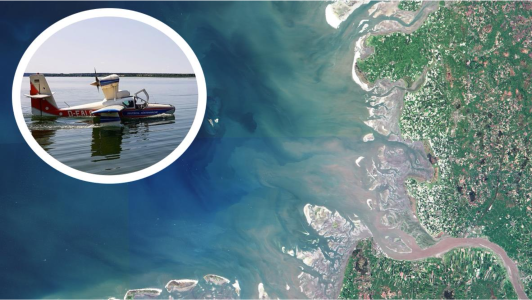AIR-SOS: airborne & satellite observation strategies for marine litter monitoring

Marine litter is a global issue; rubbish can be found in all the seas from the equator to the poles, as well as in freshwater systems, such as rivers and lakes. Most marine litter is plastic and, as plastic production continues to increase, greater impacts are expected. Plastic marine litter dramatically affects marine ecosystems and has a huge economic impact.
The emerging field of using satellites to remotely detect marine plastic is promising, but reliable in situ validation data are required to improve algorithms and approaches. In an step towards achieving this, SkyfloX, Plymouth Marine Laboratory and Aufwind proposed to use general aviation aircraft to validate and assess marine litter detection.
The resulting AIR-SOS (AIRborne & Satellite Observation Strategies for marine litter monitoring) study aimed to collect high-quality and high-resolution data in coastal waters near the mouth of the River Elbe. A seaplane (Lake Buccaneer) was used to collect multispectral data coincident with overpasses of Copernicus Sentinel-2 satellites to validate current algorithms and methodologies. In this way, the project assessed and demonstrated the value of the aircraft as a platform for validation of Sentinel-2 data.
For this project a multidisciplinary team was required. SkyfloX has experience with payload design and flight campaigns from previous projects with large consortia (DOCS-1 flight campaigns/ DOCS-2 payload design), whilst Plymouth Marine Laboratory has experience in marine litter detection projects including the PML-led ESA OPTIMAL feasibility study, which demonstrated the ability to detect floating marine vegetation, plastics and debris in Sentinel-2 satellite imagery. Aufwind, meanwhile, has expertise in flight training, flight operations and aircraft maintenance, as well as compliance management in aeronautical areas. Aufwind also owns a seaplane, LAKE LA- 4-200, formerly used for oil spill surveillance in the North Sea, which was used for this project.
The ability to fly sensors on general aviation aircraft at a lower cost and at lower altitudes (visual cross-checks), as well as the possibility to perform in-situ measurements (sea landings) make this a multi-functional ‘platform’ suitable for systematic validation of satellite remote sensing detection of marine litter. Ultimately, these methods and sensors could be used to complement satellite observations using multiple general aviation aircraft or the ORCA constellation (Optical and Radiofrequency Constellations on Airplanes).
